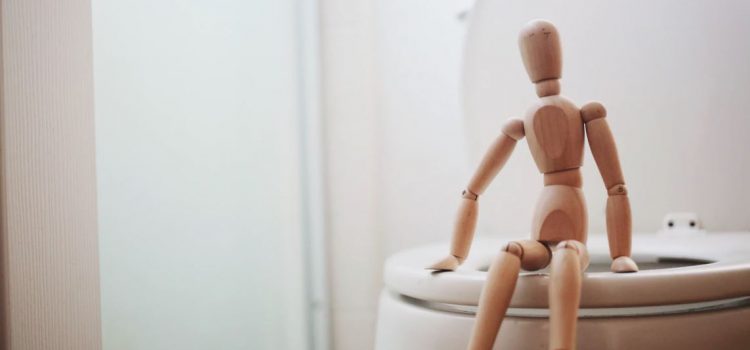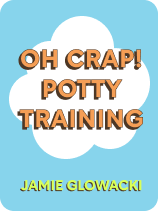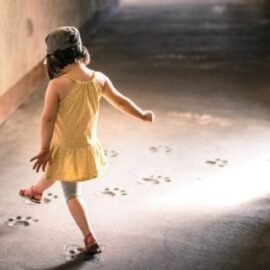

This article is an excerpt from the Shortform book guide to "Oh Crap! Potty Training" by Jamie Glowacki. Shortform has the world's best summaries and analyses of books you should be reading.
Like this article? Sign up for a free trial here .
What is the Oh Crap! method for potty training? How do you begin the potty training journey?
In Oh Crap! Potty Training, parenting coach and social worker Jamie Glowacki explains that to effectively potty train your child, all you need is a clear and consistent process that you feel confident about. Her book explores the basics of creating this process and explains how you can personalize it to your child and their needs.
Here’s an overview of Glowacki’s potty training method.
When to Begin
Glowacki recommends beginning the Oh Crap! method of potty training when your child is between 20 and 30 months old. She claims that at this age, your child will be eager to please, curious, and willing to accept new responsibilities. Any younger and they might not fully grasp what you expect of them. Any older and they’ll be more willing and able to resist you and engage in power struggles.
In addition, do not wait for your child to signal they are ready. Glowacki emphasizes that your child often won’t send these signals—they don’t know they want potty training, and will instead try and stay in their comfort zone (diapers). A toddler won’t make a large decision like when to start potty training on their own, so you have to.
Preparing
Glowacki provides several steps you should follow to prepare yourself, your home, and your child for the Oh Crap! method of potty training.
1) Ensure consistent sleep: Before you plan potty training, ensure your child is on a consistent and healthy sleep schedule. If they’re tired, they’ll be less willing to learn and more irritable, making training far more difficult.
2) Get your partner on board: Make sure you and your partner are on the same page as you prepare and go through potty training. Disagreements between you will challenge your confidence and make potty training an unclear and inconsistent process.
3) Set a date: Set aside several days (ideally a week) for starting potty training. Make sure you have absolutely no plans during this period—you’ll need to constantly pay close attention to your child for the first few days so you can get them to the toilet as needed.
4) Buy a potty chair: Buy a potty chair for your child. A potty chair is less intimidating than a normal toilet and is also easier for them to access. Don’t put it out until you start potty training, so your child only sees and uses it as a toilet.
5) Explain the process: Explain to your child that they are no longer going to wear diapers and that you’re going to train them to use the toilet. This makes it clear what’s going to happen and what you need from them.
The Phases of Potty Training
After preparations are complete, Glowacki separates potty training into five phases, explaining what each phase looks like and how to approach them. She emphasizes there’s no one “correct” length for each phase—every child has their own pace.
Phase 1: Naked
During phase one, keep your child fully bottomless and focus entirely on them while they are awake. This way, you’ll immediately notice every time they start to pee or poop. Once they do, quickly bring them to a potty chair. These steps allow your child to consistently practice using the potty, and to make a connection between the potty and the act of peeing and pooping.
As phase one progresses, start to learn the signals your child gives when they need to pee or poop—this could include agitation, becoming quiet, or signs of physical discomfort. Also learn the general rhythm of when your child pees and poops each day. These signals and rhythms help you recognize when your child needs the potty so you can prompt them to go.
Glowacki notes that, throughout these phases, it’s okay to put diapers on your child while they sleep—training your child to use the potty during the day and at night right away puts a lot of stress on you and your child. However, explain that these diapers are only temporary until they’ve trained more. This keeps your process clear and consistent.
You’ll know it’s time for phase two when your child can pee and poop on the toilet while naked, whether you take them, prompt them, or they go by themselves. This usually happens between one and three days into potty training.
Phase 2: No Underwear
For phase two, dress your child in pants with no underwear. Glowacki explains that toddlers often have trouble understanding the difference between underwear and diapers, so avoiding underwear, for now, will mean fewer accidents.
Continue learning the rhythms and signals of your child’s bathroom use, prompting them to use the toilet when they show signals or when they usually need to go. You don’t need to focus entirely on your child during this phase and can start taking them on short outings like a walk around the block or a quick errand. Be prepared for your child to have accidents during phase two, keeping cleaning supplies on hand. Don’t get angry or upset with your child if they have an accident—they’re still learning. Instead, acknowledge they made a mistake without judging them: For example, say, “Pee goes in the potty,” and then have them help you clean up the accident.
You can move on to phase three when you’re confident in your child’s ability to go on longer outings without too many accidents. This is usually somewhere between two and nine days into potty training.
Phase 3: Outings
In phase three, take your child on longer trips to new places and situations like shopping or daycare. Bring your potty chair and towels or wipes for accidents, which are still likely to happen. Prompt your child to use the potty when you notice their signals and when you’d normally prompt even a potty-trained child: before leaving the house, before going to bed, or before starting an activity.
Glowacki suggests you progress into phase four when you feel your child is ready—things will likely get easier from here on out, so potty training will become less about specific steps and more about continuing your existing approach and keeping the three C’s in mind.
Phase 4: Underwear
Phase four has one simple step: putting your child back into underwear. By this phase of potty training, they’ll have been out of diapers long enough that they’ll no longer confuse underwear with diapers. In addition, an accident in underwear is far more noticeable and unpleasant than an accident in a diaper, which will encourage toilet use. That being said, Glowacki notes that it’s possible your child will have trouble with this step, having accidents more frequently. If this is the case, you can have them go back to no underwear if needed—and don’t worry if your child needs to go without for a long time.
Phase 5: Independence
Phase five begins when your child can consistently self-initiate toilet use. Glowacki explains that this doesn’t mean you won’t have to prompt your child and won’t have any accidents, but it means these things are exceptions rather than inevitabilities—after all, children of all ages sometimes have accidents or need to be reminded to go pee. Phase five is your end goal, so make sure you pat yourself on the back for potty training your child.
Additional Challenges
While the phases act as general benchmarks for your child’s progress, Glowacki emphasizes that every child is different and will probably encounter additional challenges which prevent potty training progress. She mentions four common challenges your child might encounter while using the Oh Crap! method and suggests how to approach each of them.
Challenge #1: Poop Difficulties
Your child might have an easier time peeing in a toilet than they do pooping, which Glowacki says is perfectly normal. She offers three reasons a child might have trouble pooping in a toilet and advises how you can deal with each.
Anxiety
Just like adults, children have a hard time pooping while anxious. Glowacki explains this is a physical response—the sphincter muscles close up the anus in response to anxiety. To reduce anxiety, make pooping a normal and calm event. Talk openly with your child about poop, and offer them privacy while pooping since a parent hovering or watching often adds pressure.
Poop Rhythms
Glowacki suggests that once your child is out of diapers, they’ll likely poop less often than usual and might not poop at all the first day or two—this is perfectly normal. Pooping outside of a diaper is a new and strange feeling for your child. Help them get used to pooping by validating their feelings. This can mean talking openly about poop and how strange it feels or it could just mean giving them plenty of time to poop.
Physical Difficulty
Difficulty pooping can also have physical causes like constipation. Glowacki recommends multiple methods for easing these difficulties: Try positioning your child in a squatting position on or over the potty—this stance helps poop come out. Also, make sure your child stays hydrated and eats enough healthy fats and fiber. If nothing else works, you can also ask your pediatrician about child-friendly stool softeners or a further examination.
Challenge #2: Night Training
Glowacki claims that your child might automatically wake up to use the potty at night, but if this doesn’t happen by the time your child is three to three and a half then you’ll need to take concrete nighttime potty training steps. She offers two main steps for nighttime training:
1) Make sure your child doesn’t drink too much before bed. This way, they’ll pee less frequently at night and have fewer accidents.
2) Set two alarms at different points of the night (experiment to find the best times for preventing accidents), wake up your child, and have them pee in the potty. This consistent approach helps your child practice nighttime potty use.
Challenge #3: Resistance
While potty training, your child might resist the process. Glowacki separates reasons for resistance into two categories and offers suggestions for dealing with each.
Uncertainty
Your child may resist potty training because they feel uncertain about changing their routine or learning a new skill. Address uncertainty resistance by staying confident and making it clear that your child has to learn to use the potty. Also, don’t over prompt or hover over them while they use the potty—this only adds pressure on your child, which increases their uncertainty. Instead, prompt your child to use the toilet and then let them do it on their own.
Defiance
The other form of resistance Glowacki identifies is defiance: when your child knows how to use the toilet but chooses not to. This happens because your child is testing their limits (a normal developmental activity), or because they just don’t want to get up from an activity. In these situations, Glowacki recommends using small consequences: Have your child help you clean up the accidents, or take away a toy until they use the potty. This way, your child will recognize that their on-purpose accidents have consequences, discouraging that behavior.
Challenge #4: Restarting
Glowacki acknowledges that there might be a moment when it’s necessary to return to diapers for a time and then start potty training over later on. She calls this process “restarting” your training, and notes two main circumstances where a restart might be necessary:
1) Exhaustion: You and your child have hit your physical and emotional limits, and continuing to train won’t be productive—this is likely due to excessive resistance and power struggles.
2) Lack of understanding: Your child either never tried to understand training, or started to understand and then suddenly and unexpectedly stopped or regressed in their understanding.
How to Effectively Restart
To restart your child’s potty training, put them back into diapers but explain to them that you’re only doing so because they can’t use the potty properly and you need everyone to calm down before trying again. Put away the potty chair, and pick a day for restarting potty training two to four weeks later. These steps will allow everyone to calm down before trying again and will frame the restart as a break rather than as inconsistency in your approach.
However, there are also limits to the restart. Glowacki emphasizes that the reset can only be done once—resetting more than once teaches your child that throwing a big fit gets them what they want. She also insists that you should not reset the training of a child older than three, because a failure to potty train at that age is most likely due to behavior rather than an inability to learn.

———End of Preview———
Like what you just read? Read the rest of the world's best book summary and analysis of Jamie Glowacki's "Oh Crap! Potty Training" at Shortform .
Here's what you'll find in our full Oh Crap! Potty Training summary :
- How to practice the Oh Crap! Potty Training method
- How to overcome a number of potty training challenges
- What to do if you need to restart the potty training process






